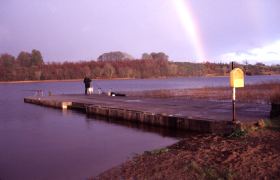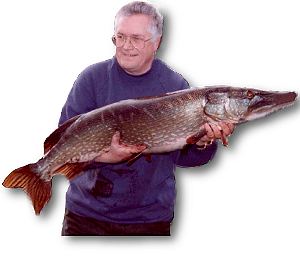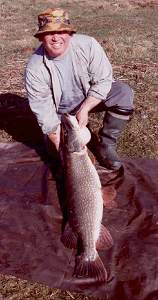There’s an old adage that more pike are to be found within a few yards of the bank than anywhere else. You might scoff, but the margins offer almost unfished territory on a lot of waters, even those that see more than their share of pressure. Give the close range approach a try this season and you might just be pleasantly surprised.
With all the methods at our disposal these days, you could be forgiven for thinking there are few areas you can’t get a bait to. You can blast them 100 yards with your latest pair of carbons. You can drift them twice as far or even land one on a sixpence with a bait boat. Pikers were obsessed with long-range fishing long before the big pit reel and distance casting culture took the carping world by storm. But have we got so blinkered by reaching for the horizon that we can’t see what’s under our feet? The honest answer for a lot of us has got to be yes. 
If you want to find one of the most unfished areas on a lot of venues, start looking within a couple of rod lengths of the bank.
Before we look at the game plan, let’s think about the tackle. ‘Give’ is the optimum word here, for reasons which will become obvious.
You’re going to be fishing close-in, for a powerful fish capable of great bursts of speed over short distances, so you need strong gear with a built-in shock absorber that can ride the first few punches the pike throws. Pumped in from 80yds range, a lot of pike come quietly all the way to the net. Hook one under your rod tip and it’s a different kettle of fish altogether.
Through-actioned rods are the order of the day, rather than fast-taper 3lb test-curve pokers. Line needs to be sensible as well. Mono has a safety margin in the form of its inherent stretch. But there’s no point skimping on strength just because you won’t be heaving a three ounce lead half way to he next county. Fifteen pound BS is a minimum if there are weedbeds, snags or obstructions of any kind in the vicinity. Margins often have all three. I favour 30lb braid for its direct contact with a hooked fish, not to mention its stopping power when you really do need to slam the brakes on. It also allows you to haul gear out of snags – or haul out snags – without leaving a tethered, baited end-rig ready to kill the next pike that comes along. Without the stretch to cushion trace, knots and hookhold it makes sense to marry braid with strong, forged treble or double hooks and one of the stronger brands of wire like Fox Easy Twist in the 30lb test.
Take my word for it, the first time an angry twenty decides to show you it can beat your average Porsche for acceleration you won’t regret it.
Margin fishing isn’t about long casting. Half the time it only takes a gentle under-arm lob to put the bait exactly where you want it. But there’s more to it than that. Like any other form of piking, the keys are location and timing. And location. And timing. Get it wrong and you might as well go back to blasting your baits out 100 yards and waiting for your number to come up. Get it right and you can fill your wellies. Margins offer you a shelf or drop-off on almost every water, whether it’s a gravel pit, river or drain. Careful plumbing can often reveal changes in depth and gradient over the space of just a few yards of bank. 
Then there are the weedbeds, overhanging trees and other obstructions which give the pike added cover to lie up and attack its prey from.
Knowing the features and fishing to them is the key. We all know pike lurk around drop-offs for the cover they afford. Yet a bait placed at the bottom of a drop-off can still be ignored on some days, or even at some times of the day, while a bait fished a few feet closer on a slope, or suspended off the bottom, will be attacked so fast you won’t even have a chance to put the rod in the rest. Timing is often another key variable. Late afternoon and dusk see margins turn to hotspots on waters that are heavily match-fished.
Think about it: The match boys have just spent five hours attracting every fish on the venue within pole range of the bank, packed keepnets full of them just out of the pike’s reach, then tipped a netful of dizzy, disoriented roach and skimmers back into the water. Why wait until the banks are deserted and the local winter league crowd are drinking their winnings or drowning their sorrows at the nearest boozer while you’re at it. Why not walk the length with the weigh-in and ask if anyone’s had small fish snatched off their poles or seen signs of pike in their swims..?
Dawn is heralded as another great feeding spell. On larger, open waters with less cover, I’ve often found pike can come to margin fishing at any time of day. Are these fish margin patrollers, that missed out on breakfast and have set off in search of an easy meal or seconds..?
Time of day is one thing. What about choice of day itself?
Go to any popular water on a Sunday afternoon and what do you see – the weekend crowd packing up, slinging all their unused baits in the margins. Turn up first thing on a Monday and you’ve probably got the place to yourself – not to mention a choice of pre-baited swims.
Technique-wise it’s hardly rocket science. Slim pencil floats, cocked by the weight of the bait and a couple of swan shot on the trace are best for deadbaiting on stillwaters. Avoid self-cocking floats whatever you do, because they don’t always show takes quickly enough to avoid deep hooking. Paternoster rigs work better with livebaits because you can put a bait where you want it and anchor it there.
A stealthy approach is an obvious must when you’re fishing close. “Just because you can’t see them don’t mean they can’t see you boy,” a favourite uncle would often remark at the young lad clumping around the skyline. He was right too. Sitting back from the water and avoiding vibrations from hammering in bank sticks is common sense.
Where possible, it makes sense to fish along the margins to cut disturbance even more. Sit 10yds or more from where you want to fish, creep down and gently plop your bait exactly where you want it, then walk quietly back to your chair.
When the wind’s blowing along a bank, drifter fishing enables you to explore margins by moving a bait along a drop-off or weed bed. A strong wind blowing in your face on bigger waters will sometimes allow you to move a bait out in the undertow, by sinking the line and rod tip and using a longer float to counteract the waves.
Trotting is classic margin method on rivers and drains. A through-the-middle slider, coupled with floating line are best for this. There are a couple of other wrinkles which can sometimes produce a take. Trotting alongside overhanging trees, moored boats or inaccessible areas are all worthwhile dodges. 
So is holding the float back so the bait rises in the current, before allowing it to flutter back down to the bottom. Or slowly retrieving it upstream so it spins and wobbles.
Whatever method you plump for ring the changes. And that goes for swims too. You don’t need four rods, a bivvy and a lorry-load of gear so it’s easy to up sticks and move if the fish aren’t showing.
Margin fishing lets you see takes develop at close range, so there’s no excuse for deep hooking fish. The float will usually bob sharply as the pike hits your bait. Then it’ll submerge and the line will tighten as the pike turns down and uses the rushof water through its mouth and gills to turn and swallowing it. As soon as it moves hit it. If the hooks are properly spaced, one or the other should find a hold in the scissors, or just inside of the mouth. Leave it any longer and you risk deep hooking whether you’re fishing five yards out or 50.
If you’re fishing a few yards out, there’s no need to hit a fish anything like as hard as you would at longer ranges. A firm pull is all it takes. Before you get a take is the time to think about weedbeds, overhanging trees and other potential snags, rather than hauling a half-beaten fish over a weedbed it’ll promptly crash dive into when it sees the landing net and gets its second wind.
Bigger fish will usually react by shaking their heads violently, then running directly away from you. If there’s clear water in front of you let them go and fight them out in the clearer water. You might think fishing near overhanging trees, mats of flotsam, boats, etc, is asking for it. The way to stop a fish in its tracks is to submerge the rod tip as deep as you can to stop the line catching on branches, the hull of the boat or whatever and hold on – the rod will absorb the lunges and if the tackle’s sound and the hooks hold you can usually kite them away from trouble.
Margin fishing won’t work every time. But it adds another string to your bow and you’d be surprised how often so-called hard waters produce the goods to the stealthy close-range piker.










